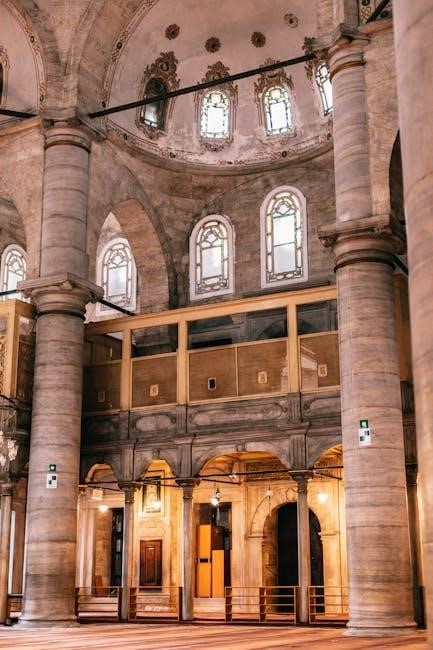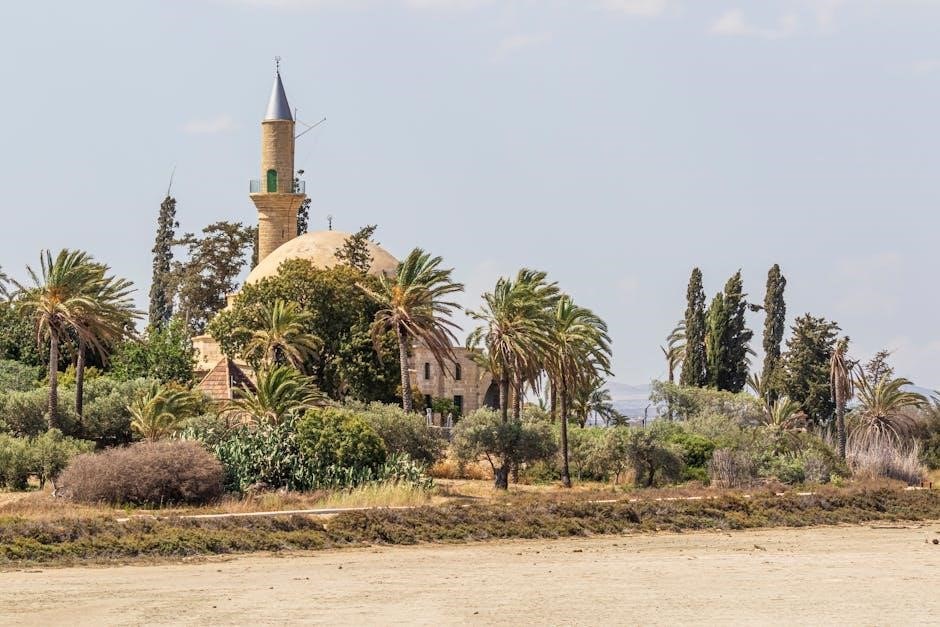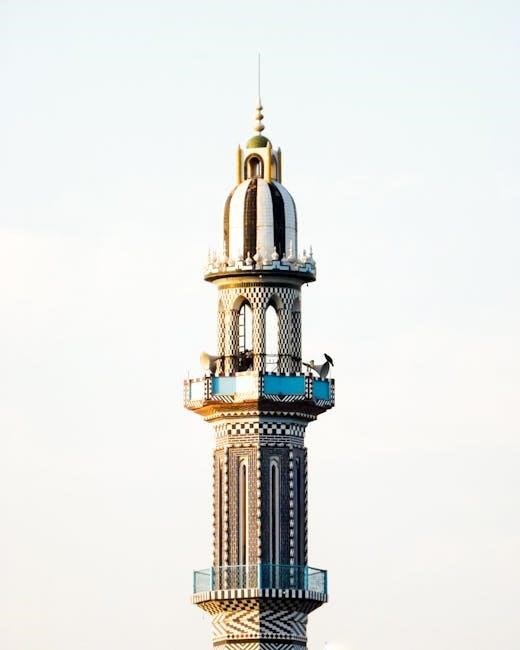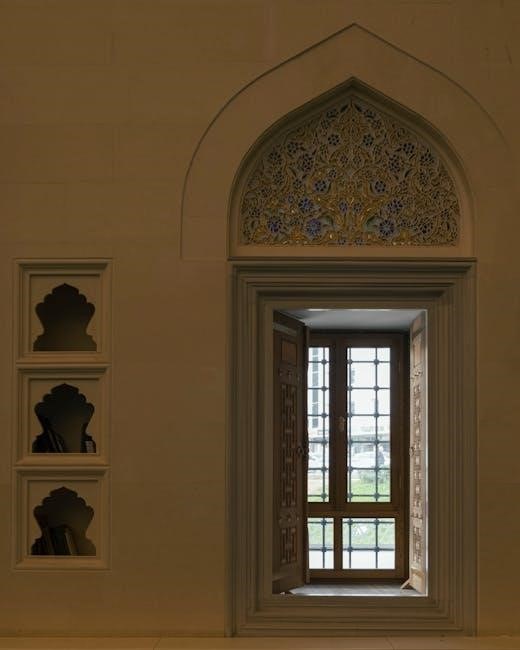Origin and Early History of Islam
Islam emerged in 7th-century Arabia, traced to Prophet Muhammad’s revelations in 610 CE. Born in 570 CE in Mecca, Muhammad’s teachings emphasized monotheism and moral reform, leading to the Quran’s compilation. The Hijra in 622 CE marked the beginning of the Islamic calendar, solidifying the Muslim community’s foundation.
1.1. The Birth of Prophet Muhammad and His Early Life
Prophet Muhammad was born in 570 CE in Mecca, Arabia, to the Quraysh tribe. Orphaned at a young age, he was raised by his uncle Abu Talib. Muhammad’s early life was marked by a reputation for honesty and integrity, earning him the title “Al-Amin” (the trustworthy). He worked as a merchant and later married Khadijah, a wealthy widow, at the age of 25. His contemplative nature led him to spend time in isolation, reflecting on spirituality. This period laid the groundwork for his prophetic mission, which began at age 40 with divine revelations. His early life shaped his character, emphasizing compassion, justice, and moral integrity, which became foundational to his teachings and the Islamic faith.
1.2. The First Revelation and the Beginning of Islam
In 610 CE, Prophet Muhammad received his first revelation in a cave near Mecca during Ramadan. The angel Gabriel delivered the divine message, which became the first verses of the Quran. This event, known as the Night of Revelation, marked the beginning of Islam. Initially, Muhammad shared his message with close family and friends, who accepted him as a prophet. The revelations emphasized monotheism, moral accountability, and social justice, challenging Mecca’s polytheistic traditions. Over time, the message spread publicly, leading to both acceptance and opposition. This period laid the foundation for the Islamic community and its teachings, transforming Arabian society and beyond. The revelation’s authenticity and Muhammad’s prophethood are central to Islamic belief, shaping the faith’s principles and practices.
1.3. The Migration to Medina (Hijra) and Its Significance

In 622 CE, Prophet Muhammad migrated from Mecca to Medina, an event known as the Hijra, marking a pivotal moment in Islamic history. Faced with increasing persecution, Muhammad and his followers sought refuge in Medina, where they established the first Islamic community. The Hijra not only ensured the survival of Islam but also laid the foundation for its rapid expansion. This migration marked the beginning of the Islamic calendar and symbolized a transition from a persecuted minority to a thriving community. In Medina, Muhammad became both a religious and political leader, unifying the city under Islamic principles. The Hijra’s significance lies in its role as a turning point, enabling the spread of Islam and the creation of a structured Muslim society. It remains a cornerstone of Islamic identity and history.

The Expansion of Islam After Muhammad’s Death

Following Muhammad’s death, Islam expanded rapidly under the Rashidun Caliphs, spreading into the Levant, Persia, and Egypt, establishing a vast Islamic empire and fostering cultural growth.
2.1. The Rashidun Caliphate and Its Role in Islamic Expansion

The Rashidun Caliphate, spanning 632–661 CE, was pivotal in Islamic expansion. Abu Bakr, Umar, Uthman, and Ali led the community, uniting Arabia and conquering vast territories. Military campaigns expanded Islam into the Levant, Persia, and North Africa, establishing a centralized Islamic state. The caliphs ensured justice, fairness, and adherence to Islamic principles, fostering a cohesive society. Their leadership laid the foundation for later caliphates and the spread of Islamic culture, shaping the political and religious landscape of the Middle East and beyond.
2.2. The Umayyad Caliphate and the Spread of Islam
The Umayyad Caliphate, established in 661 CE, marked a significant era in Islamic history, characterized by rapid territorial expansion and administrative reforms. With its capital in Damascus, the caliphate extended Islamic rule into Spain, Portugal, and Central Asia, creating one of the largest empires in history. The Umayyads implemented a centralized governance system, introducing postal systems and standardized currency. They also patronized architecture, exemplified by landmarks like the Dome of the Rock in Jerusalem. Despite internal conflicts and regional tensions, the Umayyads played a crucial role in spreading Islam and fostering cultural exchange. Their reign ended with the Abbasid Revolution in 750 CE, shifting the caliphate’s center to Baghdad and ushering in a new era of Islamic governance.
2.3. The Abbasid Caliphate and the Golden Age of Islam
The Abbasid Caliphate, established in 750 CE, initiated the Islamic Golden Age, a period of remarkable cultural, scientific, and intellectual growth. With Baghdad as its capital, the empire became a hub for learning, attracting scholars from diverse backgrounds. The Abbasids promoted translations of Greek, Persian, and Roman texts, preserving ancient knowledge and advancing fields like mathematics, astronomy, and medicine. Key figures such as Al-Khwarizmi and Ibn Sina made groundbreaking contributions. The caliphate also saw architectural advancements, including the construction of the House of Wisdom, a center for academic excellence. This era laid the foundation for Islamic thought and innovation, shaping global intellectual heritage and leaving a lasting legacy in various scientific disciplines.
2.4. The Spread of Islam into Europe, Asia, and Africa
Islam expanded rapidly beyond Arabia, reaching Europe, Asia, and Africa through trade, conquest, and cultural exchange. The Umayyad Caliphate extended Islamic rule to Spain, while Central Asia and the Indian subcontinent embraced Islam through Sufi missionaries. In Africa, Islam spread along the Sahara trade routes, influencing regions like Mali and Ethiopia. Muslim traders and scholars played a pivotal role in disseminating Islamic teachings, blending with local cultures to create diverse Muslim communities. This vast expansion not only established Islam as a global religion but also fostered cross-cultural exchanges, leaving a lasting legacy in art, science, and governance across these continents.
The Cultural and Intellectual Contributions of Islam
Islam’s Golden Age saw advancements in science, medicine, and mathematics, with scholars like Al-Khwarizmi pioneering algebra. Islamic art and architecture, such as mosques, showcased geometric precision and beauty, while preserving ancient knowledge and fostering cultural exchange globally.

3.1. The Islamic Golden Age and Its Achievements
The Islamic Golden Age, spanning the 8th to 14th centuries, was a period of remarkable cultural and intellectual growth. Scholars like Al-Khwarizmi pioneered algebra, while Al-Biruni and Ibn Sina made groundbreaking contributions to medicine and astronomy. Islamic art flourished, characterized by intricate calligraphy and geometric patterns. The preservation and translation of ancient Greek and Roman texts in centers like Baghdad’s House of Wisdom laid the foundation for the Renaissance. This era also saw advancements in engineering, optics, and chemistry, with innovators such as Al-Hazen and Al-Zahrawi. The Islamic Golden Age not only enriched Islamic civilization but also left a lasting legacy that shaped global scientific and cultural progress.

3.2. Contributions to Science, Mathematics, and Medicine
Islamic scholars made profound contributions to science, mathematics, and medicine during the Islamic Golden Age. Al-Khwarizmi introduced algebra, revolutionizing mathematics, while Al-Battani’s work in astronomy corrected Ptolemy’s errors. In medicine, Ibn Sina’s “The Canon of Medicine” became a cornerstone of medical education for centuries. Al-Zahrawi’s surgical techniques and Ibn Al-Haitham’s theories on optics were equally groundbreaking. These advancements were fueled by the translation of ancient texts and innovative research, establishing Islamic scholars as pioneers in their fields. Their works significantly influenced later scientific developments in Europe and beyond, showcasing Islam’s enduring legacy in the sciences. This period laid the foundation for modern scientific inquiry and remains a testament to Islamic intellectual brilliance.
3.3. The Role of Islamic Art and Architecture
Islamic art and architecture are renowned for their elegance and spiritual depth. Characterized by intricate geometric patterns, calligraphy, and arches, they reflect the unity and harmony central to Islamic values. Iconic structures like the Dome of the Rock and the Alhambra showcase architectural innovation and cultural brilliance. These designs often symbolize divine infinity and transcendence, avoiding figurative representations. The use of domes, minarets, and courtyards in mosques highlights functional and aesthetic balance. Islamic art also preserved and advanced techniques from ancient civilizations, blending them with unique Islamic styles. This cultural expression flourished during the Golden Age, influencing art globally. Islamic architecture and art serve as a testament to the faith’s enduring legacy in creativity and cultural exchange.

The Diversity of Islamic Thought and Practice
Islam encompasses a rich diversity of thought and practice, including Sunni, Shia, and Sufi traditions, each offering unique interpretations of faith, spirituality, and communal life.
4.1. The Sunni-Shia Division and Its Historical Roots
The Sunni-Shia division emerged after the death of Prophet Muhammad, centered on disputes over leadership succession. Sunnis supported Abu Bakr, while Shias favored Ali, Muhammad’s cousin and son-in-law. This split deepened over theological and political differences, with Sunnis emphasizing consensus and Shias focusing on divine right through Muhammad’s family. Historical events, such as the Battle of Karbala, further solidified these divisions. Sunnis constitute the majority, while Shias form significant minorities in regions like Iran and Iraq. Despite shared beliefs, their distinct interpretations of authority and tradition continue to shape Islamic thought and practice, influencing cultural and political dynamics across the Muslim world.
4.2. The Emergence of Sufism and Its Influence
Sufism emerged in the early Islamic period as a mystical response to the growing worldliness of the expanding Islamic empire. Rooted in the teachings of the Quran and the Prophet Muhammad, Sufis sought a deeper, personal connection with God through spiritual practices like asceticism, meditation, and devotional acts such as dhikr (remembrance of God). This movement emphasized inward purification and the attainment of spiritual states, often expressed through poetry and music. Key figures like Rumi and Hafez became central to Sufi traditions, blending spiritual insight with artistic expression. Sufism played a significant role in the spread of Islam, particularly in regions beyond the Arab world, as Sufi mystics and saints attracted followers with their teachings of love and spirituality. Their influence continues to shape Islamic culture and religious practice globally;
4.3. Other Sects and Movements Within Islam
Beyond Sunni and Shia divisions, Islam encompasses diverse sects and movements. The Kharijites, emerging after Muhammad’s death, emphasized strict adherence to Islamic law and rejected mainstream leadership. The Ibadis, a moderate offshoot of the Kharijites, focus on peaceful coexistence and are prominent in Oman. Modern movements like the Ahmadiyya, founded in 19th-century India, emphasize global outreach and peaceful propagation of Islam. These sects reflect Islam’s theological and cultural diversity, often arising from historical disputes over leadership, interpretation, or practice. They contribute to the rich tapestry of Islamic thought and practice, showcasing the religion’s adaptability across different contexts and regions.
Key Texts and Sources in Islamic History
The Quran, Hadith, and classical histories form the cornerstone of Islamic scholarship, providing divine revelation, prophetic traditions, and historical context essential for understanding Islamic faith and civilization.
5.1. The Quran and Its Significance
The Quran is the holy book of Islam, believed to be the literal word of God as revealed to Prophet Muhammad through the Angel Gabriel over 23 years. Divided into 114 chapters, or surahs, it serves as the primary source of Islamic teachings, guiding followers on faith, worship, ethics, and law. Muslims consider the Quran the ultimate authority and a miracle, both in its message and literary style. Its preservation in both written and oral forms has ensured its integrity, making it a central pillar of Islamic practice and belief, shaping the spiritual, moral, and intellectual life of Muslims worldwide.
5.2. The Hadith and Its Role in Islamic Tradition
The Hadith, comprising the sayings, actions, and approvals of Prophet Muhammad, is a cornerstone of Islamic tradition. It provides insights into his life, decisions, and practices, serving as a practical guide for Muslims. Collected by his companions and later scholars, the Hadith is categorized into Sahih (authentic), Hasan (good), and Daif (weak) based on the reliability of the chain of narration. Major collections include Sahih Bukhari, Sahih Muslim, and others. The Hadith complements the Quran, offering detailed explanations of rituals, ethics, and legal principles. It is a vital source for Islamic jurisprudence, influencing daily life, worship, and moral conduct. The Hadith ensures the Prophet’s teachings remain central to Islamic practice, bridging revelation and practical application.
5.3. Classical Histories of Islam and Their Authors
Classical histories of Islam are foundational texts documenting the faith’s early development. Authors like Ibn Hisham and Ibn Ishaq chronicled the Prophet Muhammad’s life, while Al-Tabari’s “Tarikh al-Rusul wa al-Muluk” is a seminal work on Islamic history. These scholars meticulously recorded events, ensuring preservation of historical accuracy. Their works cover the Hijra, the Rashidun Caliphate, and the expansion of Islam. These texts remain essential for understanding the evolution of Islamic civilization and its cultural impact. They offer detailed insights into key events and figures, shaping the narrative of Islam’s rise and influence, providing scholars and historians with valuable primary sources and enriching the study of Islamic history.

Modern and Contemporary Issues in Islamic History
Modern Islamic history grapples with colonialism’s legacy, Islamist movements’ rise, and global challenges. These factors shape Muslim societies, influencing cultural, political, and religious identities worldwide.
6.1. The Impact of Colonialism on Muslim Societies
Colonialism profoundly shaped Muslim societies, disrupting political, cultural, and religious structures. European powers imposed control over Muslim-majority regions, undermining indigenous systems and causing economic exploitation. This era led to the decline of historic Islamic institutions and the rise of new identities. Resistance movements emerged, blending Islamic ideals with anti-colonial activism. The legacy of colonialism continues to influence modern Muslim nations, shaping their political landscapes and cultural narratives. Post-colonial states often grappled with balancing Islamic traditions and modern governance, leading to ongoing debates about identity and sovereignty in the contemporary Muslim world.
6.2. The Rise of Islamist Movements in the 20th Century
The 20th century witnessed the emergence of Islamist movements, driven by the decline of colonialism and a quest for Islamic identity. Groups like the Muslim Brotherhood, founded in 1928, sought to reconcile Islamic principles with modern governance. The Iranian Revolution of 1979 marked a turning point, establishing an Islamic republic and inspiring similar movements globally. These movements often arose as responses to secular nationalism and Western influence, advocating for the implementation of Sharia and a return to Islamic authenticity. Influential thinkers such as Sayyid Qutb and Abul Ala Maududi shaped Islamist ideologies, emphasizing the need for Islamic governance. While some movements pursued gradual reform, others adopted more radical approaches, leading to diverse outcomes across the Muslim world.
6.3. Islam in the Modern World and Its Challenges
In the modern era, Islam faces numerous challenges, including globalization, secularism, and political extremism. Muslim-majority countries grapple with issues like democracy, human rights, and gender equality, often seeking to balance tradition with contemporary values. The rise of extremist groups has led to global scrutiny, complicating Muslim communities’ relationships with Western societies. Additionally, debates over Islamic reform and interpretations of Sharia law continue to shape the religion’s role in public life. Despite these challenges, Islam remains a vibrant faith, with growing populations and diverse cultural expressions. Efforts to promote interfaith dialogue and address misconceptions are ongoing, aiming to foster understanding and integration in an increasingly interconnected world.

Resources for Further Study
Explore comprehensive resources like “A Brief History of Islam” and “The History of Islam” in PDF formats, offering detailed insights into Islamic civilization and its evolution over centuries.
7.1. Recommended Books on Islamic History
For an in-depth understanding of Islamic history, several books are highly recommended. A Brief History of Islam by Huston Smith provides a concise overview, tracing Islam’s origins to its global influence. The History of Islam by Akbar Shah Khan Najeebabadi offers a detailed account in three volumes, covering key events and figures. Islamic Civilization: A History by Chase F. Robinson explores the cultural and political dimensions of Islam’s spread. Additionally, The Oxford History of Islam, edited by John L. Esposito, presents a comprehensive analysis of Islamic civilization. These books, available in PDF formats, offer valuable insights for both scholars and general readers, ensuring a well-rounded understanding of Islamic history and its significance.
7.2. Online Archives and PDF Resources
Several online archives and PDF resources provide extensive insights into Islamic history. Google Drive hosts comprehensive PDFs, such as the three-volume History of Islam by Akbar Shah Khan, offering detailed accounts of Islamic civilization. Platforms like Archive.org feature works like A Brief History of Islam, which covers key events from the 7th century to modern times. Additionally, academic repositories and websites like Academia.edu provide access to scholarly articles and eBooks on Islamic history. These resources are invaluable for researchers and students, offering a wealth of information in easily accessible formats. They cover topics ranging from the life of Prophet Muhammad to the expansion of Islam and its cultural contributions, ensuring a rich and comprehensive understanding of Islamic history.